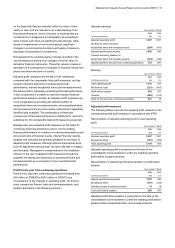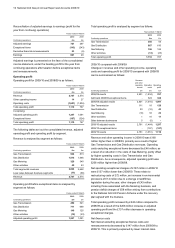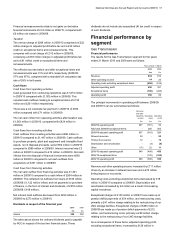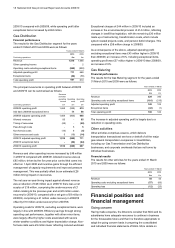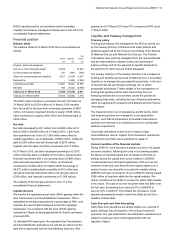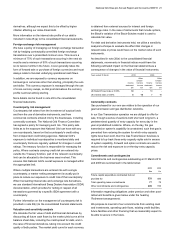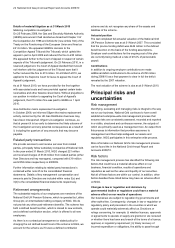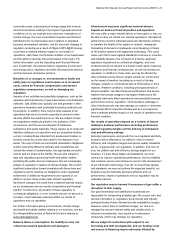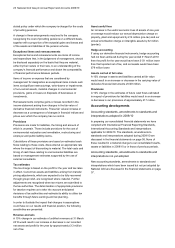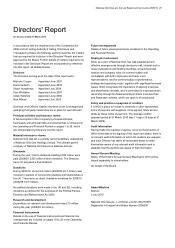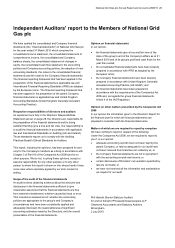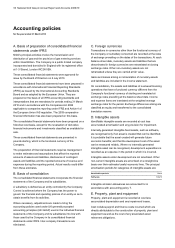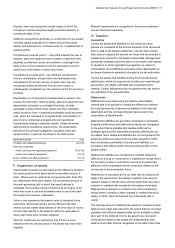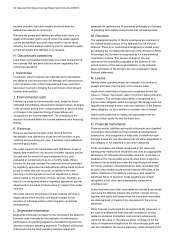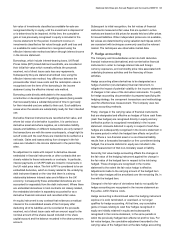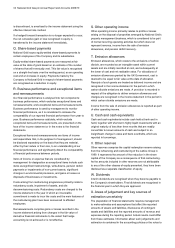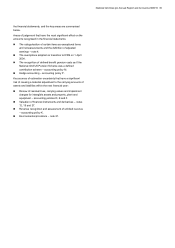National Grid 2010 Annual Report Download - page 27
Download and view the complete annual report
Please find page 27 of the 2010 National Grid annual report below. You can navigate through the pages in the report by either clicking on the pages listed below, or by using the keyword search tool below to find specific information within the annual report.National Grid Gas plc Annual Report and Accounts 2009/10 25
Accounting policies
Basis of accounting
The consolidated financial statements present the results of
NGG for the years ended 31 March 2010 and 2009 and
financial position as at 31 March 2010 and 2009. They have
been prepared using the accounting policies shown, in
accordance with International Financial Reporting Standards
(IFRS).
In complying with IFRS, we are also complying with the version
of IFRS that has been endorsed by the European Union for use
by listed companies.
IFRS differ from UK Generally Accepted Accounting Principles
(UK GAAP).
Choices permitted under IFRS
IFRS provide certain options available within accounting
standards. Material choices NGG has made, and continues to
make, include the following:
Presentation formats
We use the nature of expense method for our income statement
and total our balance sheet to net assets and total equity.
In the income statement, we present subtotals of total operating
profit, profit before tax and profit from continuing operations,
together with additional subtotals excluding exceptional items
and remeasurements. Exceptional items and remeasurements
are presented on the face of the income statement.
Capital contributions
Contributions received prior to 1 July 2009 towards capital
expenditure are recorded as deferred income and amortised in
line with depreciation on the associated asset.
Financial instruments
We normally opt to apply hedge accounting in most
circumstances where this is permitted.
Critical accounting policies
The application of accounting principles requires us to make
estimates, judgments and assumptions that may affect the
reported amounts of assets, liabilities, revenue and expenses
and the disclosure of contingent assets and liabilities in the
accounts. On an ongoing basis, we evaluate our estimates
using historical experience, consultation with experts and other
methods that we consider reasonable in the particular
circumstances to ensure compliance with IFRS. Actual results
may differ significantly from our estimates, the effect of which
will be recognised in the period in which the facts that give rise
to the revision become known.
Certain accounting policies, described below, have been
identified as critical accounting policies, as these policies
involve particularly complex or subjective decisions or
assessments. The discussion of critical accounting policies
below should be read in conjunction with the description of our
accounting policies set out in our consolidated financial
statements.
Estimated economic lives of property, plant and equipment
The reported amounts for depreciation of property, plant and
equipment and amortisation of non-current intangible assets
can be materially affected by the judgments exercised in
determining their estimated economic lives.
Carrying value of assets and potential for impairments
The carrying value of assets recorded in the consolidated
balance sheet could be materially reduced if an impairment
were to be assessed as being required. Impairment reviews are
carried out when a change in circumstance is identified that
indicates an asset might be impaired. An impairment review
involves calculating either or both of the fair value or the value-
in-use of an asset or group of assets and comparing with the
carrying value in the balance sheet.
These calculations involve the use of assumptions as to the
price that could be obtained for, or the future cash flows that will
be generated by, an asset or group of assets, together with an
appropriate discount rate to apply to those cash flows.
Revenue
Revenue includes an assessment of transportation services
supplied to customers between the date of the last invoice and
the year end. Changes to the estimate of the transportation
services supplied during this period would have an impact on
the reported results.
Estimates of unbilled revenues amounted to £184 million at 31
March 2010 compared with £189 million at 31 March 2009.
Assets and liabilities carried at fair value
Certain financial investments and derivative financial
instruments are carried in the balance sheet at their fair value
rather than historical cost.
The fair value of financial investments is based on market
prices, as are those of derivative financial instruments where
market prices exist. Other derivative financial instruments are
valued using financial models, which include judgements on, in
particular, future movements in exchange and interest rates.
Hedge accounting
Derivative financial instruments are used to hedge certain
economic exposures arising from movements in exchange and
interest rates or other factors that could affect either the value
of the Company’s assets or liabilities or affect future cash flows.
Movements in the fair values of derivative financial instruments
may be accounted for using hedge accounting where the
relevant eligibility, documentation and effectiveness testing
requirements are met. If a hedge does not meet the strict
criteria for hedge accounting, or where there is ineffectiveness
or partial ineffectiveness, then the movements will be recorded
in the income statement immediately instead of being
recognised in the statement of recognised income and expense
or by being offset by adjustments to the carrying value of debt.
Pensions
Defined benefit pension obligations are accounted for as if the
National Grid UK Pension Scheme were a defined contribution
scheme as there is neither a contractual arrangement, nor a


